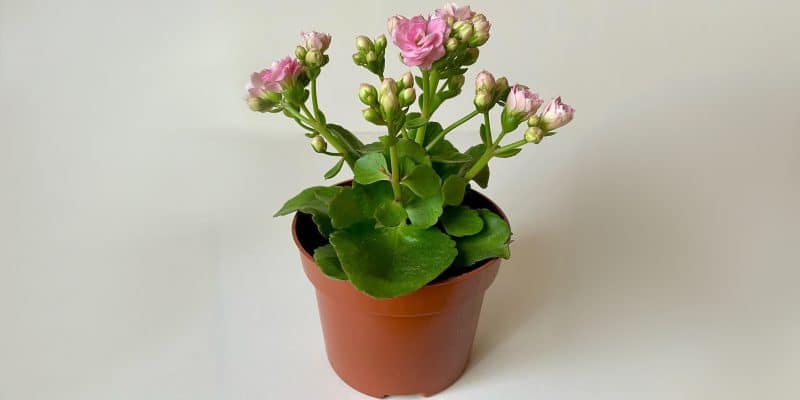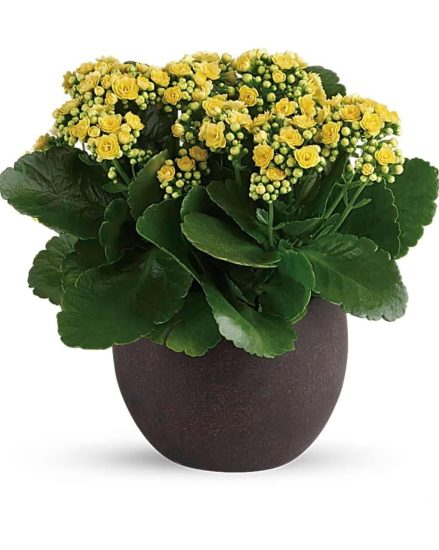Kalanchoe (Kalanchoe blossfeldiana) is a fascinating houseplant that hails from the enchanting island of Madagascar. It’s a slow-growing, bushy succulent decked out in flowers that look like miniature roses (swoon!).
Oh, and did we mention its blooms come in numerous dazzling shades like red, pink, orange, yellow, and white? You’ll be sure to find one that you’ll absolutely love.
Kalanchoe care is a breeze, since this plant is incredibly adaptable. We’ll guide you through all the essentials for keeping your Kalanchoe happy, healthy, and blooming!
Table of Contents
Kalanchoe Plant Care Guide
History, Habitat, and Characteristics
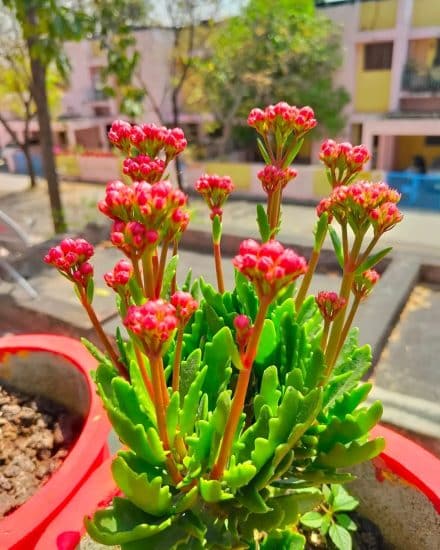
Kalanchoe blossfeldiana, an adorable plant that hails from the island of Madagascar, is a popular choice among succulent plants. Talk about exotic!
While our furry friends from Madagascar might steal the spotlight, this vibrant, flowering plant — often referred to by the common names of Flaming Katy or Christmas Kalanchoe — has secretly wooed gardeners and houseplant fans all around.
The Kalanchoe’s claim to fame? It has a superstar status as one of the longest blooming houseplants (no big deal). With an abundance of flower buds, it’ll bloom for months, sprouting colorful flowers in red, pink, orange, yellow, and white. You’ll swear the Kalanchoe flower clusters look just like little roses!
Fun fact: Kalanchoe plants are often dubbed the “magic plant” or “life everlasting” because they can reproduce using their own leaves! Tiny plantlets sprout along the leaf’s edge, and soon enough, they’ll drop and grow into a whole new plant. Pretty amazing, huh?
You’ll notice that Kalanchoes have a bushy growth habit, giving them that lush, leafy look we love. They’re perfect for adding a fresh touch of greenery to your space and impressing your friends.
Ready for the cherry on top? Kalanchoes bloom in response to daylight, so to keep those vibrant flowers popping up all year round, be sure to give them enough light exposure. Trust us, those cheerful blooms will make your home feel like a tropical paradise!
Kalanchoe Varieties
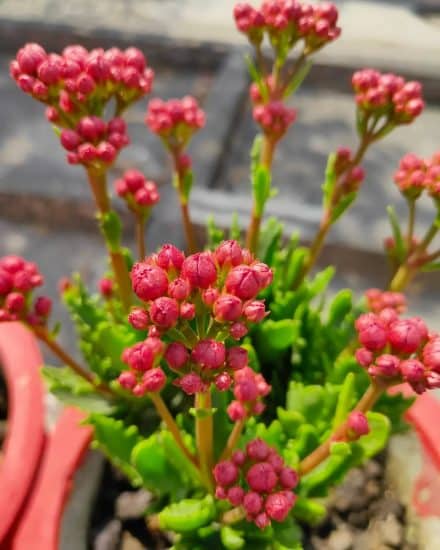
There are dozens of Kalanchoe varieties, each with its own irresistible charm. Kalanchoes can be divided into two types, those loved for their flowers and those that are prized for their foliage alone. We’ll go over a few of our favorites here.
Flowering Kalanchoes
Pendant Flowered Kalanchoe (Kalanchoe ‘Tessa’) – Pendent stems (like a chandelier!) that grow fleshy oval leaves with red margins and reddish-orange tube-shaped flowers at the ends.
Lavender Scallops (Kalanchoe fedschenkoi): Upright stems, light green leaves, and tons of small coral flowers shaped like bells.
Foliage Kalanchoes
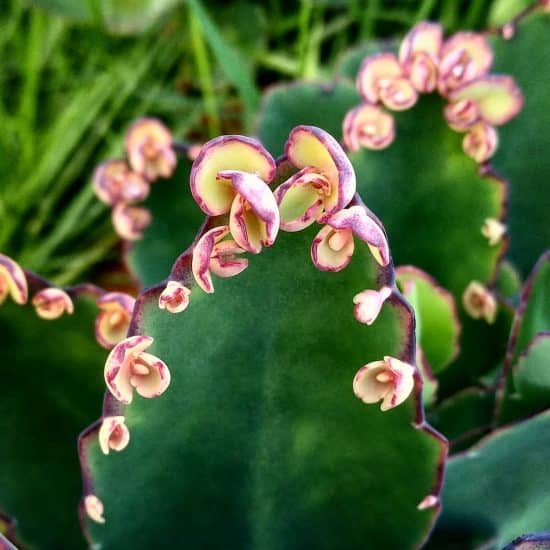
Pies from Heaven (Kalanchoe rhombopilosa): Triangle-shaped leaves with brownish-copper coloring and beige margins. There are variations with entirely white leaves (Kalanchoe rhombopilosa var. argentea) and thick deep green leaves (Kalanchoe rhombopilosa var. viridifolia).
Paddle Plant (Kalanchoe luciae): Mostly prized for its foliage, but it does grow flowers! Green oval leaves that grow in rosettes and look like clamshells. In bright light, they develop vivid red tips in winter. Dark yellow flowers smell sweet. Often mistaken for Kalanchoe thyrsiflora.
Mother of Thousands (Kalanchoe daigremontiana): Many (thousands!) baby plantlets grow on its large triangular green leaf edges. Mostly loved for its foliage, but can produce small gray and lavender flowers. Considered invasive, so best grown in a pot.
(Mother of Thousands care guide available here!)
Panda Plant (Kalanchoe tomentosa): Also called Chocolate Soldier, Panda Plant has furry silver leaves with spotted brown tips, covered by soft hairs. They almost look like cat ears! Easy to grow in light that’s bright. It can bloom, but is mostly prized for its foliage.
Light
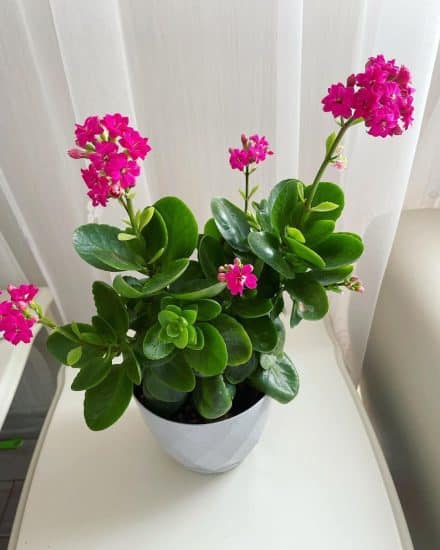
Your Kalanchoe blossfeldiana loves consistent indirect light, but direct sunlight isn’t its friend. Those hot summer rays of bright light can scorch the leaves and put a damper on blooming. So, make sure to keep your Kalanchoe basking in filtered natural light and away from that windowsill.
On the flip side, if your plant is left in a dimly lit area, those leaves will stretch out in their search for the light and end up with a spindly, gangly appearance.
Signs of too much direct light:
- Scorched or burned leaves
- Fading plant colors
- Hindered blooming (curtailing that flower power)
Signs of not enough light:
- Stretchy, spindly leaves
- Plant leaning toward the light source
- Stunted or slowed growth
Water
Getting the watering right for your indoor Kalanchoe blossfeldiana, also known by the common name Florist Kalanchoe, is super important for its overall health and well-being. Since it’s a succulent perennial, this little buddy stores moisture in its waxy green leaves and can go without water for quite a while. But striking the right balance is key for successful growth.
If your Florist Kalanchoe isn’t getting enough water, you’ll notice wilted or shriveled leaves and an overall unhappy appearance. This means it’s time to give your plant a drink.
However, over-watering can lead to issues like fungus, root rot, and stem rot, which may cause premature death. Beware of signs like yellowing leaves, soft and mushy stems, and constantly damp soil.
During the summer months, water your Flowering Kalanchoe once every 10 days or when the soil feels really dry. In winter, the plant needs less water, so once every 2 weeks should be enough. Be sure to water at the base of the soil until water drains out of the bottom of the pot.
Remember, good drainage is essential for Kalanchoe blossfeldiana, so a pot with holes at the bottom is a must-have.
Temperature and Humidity
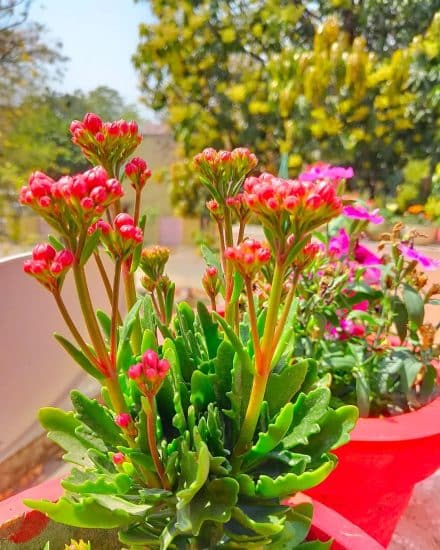
The Christmas Kalanchoe loves warm, arid environments and can be content outdoors as long as temperatures stay above 50°F. Indoors, the ideal temperature range for these vibrant succulent plants is between 55-80°F. It’s crucial to keep them away from cold drafts and freezing temperatures, so be vigilant about their location within your home.
During the summer months, your Kalanchoe blossfeldiana can tolerate being outside in filtered or bright light. However, always remember to bring them back indoors once the temperature starts to drop.
If you see any leaves beginning to yellow or wilt, it may be due to exposure to drafts or extreme temperature changes. Ensure you provide a stable environment for your Kalanchoe blossfeldiana to flourish.
Normal indoor humidity typically suits them just fine. Signs of too much or too little humidity in your Christmas Kalanchoe might not be apparent right away, as these sturdy plants can tolerate a range of humidity levels.
If you notice drooping, wilting, or browning of the leaves, it could indicate an issue with humidity levels or a sudden temperature change.
Our temperature and humidity tips:
- Keep your Flaming Katy plant in temperatures between 55-80°F, away from windows and drafty doorways.
- Normal indoor humidity is typically suitable for these plants; no extra effort is required.
- If you believe humidity is an issue, consider using a pebble tray or a humidifier to boost moisture levels.
- Don’t hesitate to place your Kalanchoe blossfeldiana outside during warmer months with the proper light conditions.
Soil and Planting
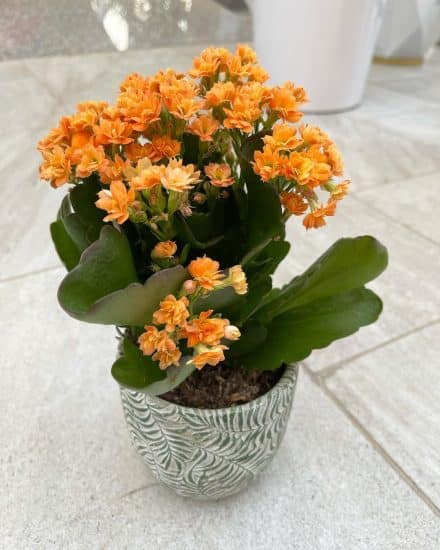
Let’s talk about the right soil, potting, and fertilizer requirements for your flowering Kalanchoe (Kalanchoe blossfeldiana), also known by the common name Florist Kalanchoe.
First, make sure your pot has drainage holes at the bottom to prevent soggy soil. Place a tray beneath the pot to collect excess water and discard it after watering.
Like many succulents, such as the jade plant, Kalanchoes require well-draining sandy soil.
A blend of 50% cacti or succulent mix and 50% potting mix, or 60% peat moss and 40% perlite, is ideal for these plants. Consider using a clay or terracotta pot to help absorb excess water and prevent soggy soil, which can harm the plant’s health.
Signs of poor soil include weakened and discolored leaves or slow growth. The wrong potting mix may cause rotting roots, ultimately killing your Kalanchoe blossfeldiana. If you suspect issues due to poor soil, repot it using a better soil mix as mentioned earlier, and ensure proper drainage.
Now, Kalanchoes are slow growers, taking anywhere from 2-5 years to reach their full size. What does that mean for you? Well, they’re super low-maintenance plants and great for both new plant parents or seasoned green thumbs alike.
Fertilizer
You can begin fertilizing your Kalanchoe plant once it’s no longer dormant, typically in early spring. Use a well-balanced indoor fertilizer, vermicompost, organic compost, or worm castings to keep the mother plant healthy and blooming.
Fertilize once a month during the spring and summer, using a potassium-rich fertilizer to encourage more buds and blooms for your Flowering Kalanchoe.
Signs of over-fertilizing include deformed growth or yellowing leaves. If this happens, stop fertilizing immediately, flush the soil with water, and resume a more diluted fertilizer schedule.
Propagation
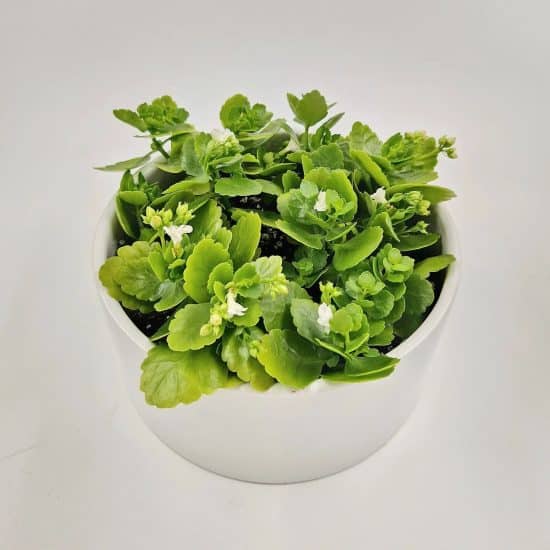
Are you looking to propagate your Kalanchoe and grow more of these adorable plants? You’ve got two options: stem cuttings or leaf cuttings. Either way, your Kalanchoe plant will be thrilled to add some new family members.
Propagating Kalanchoe through stem cuttings:
- First, pick a happy, healthy stem with a few leaves on it. Grab some sterilized gardening shears and snip a 4-6 inch segment just below a leaf node.
- Next, let’s give the cut end some airtime! Let it dry out for a day or two, so it forms a crusty layer. Trust us — this prevents any rot issues when you place the cutting in soil or water.
- Now it’s time to make a choice: soil or water for your Kalanchoe plant cutting? For soil propagation, plant the crusty end an inch deep in some well-draining potting mix. Keep the watering minimal until the roots start to show up.
- If you opt for water propagation instead, place the cutting directly into a container of water — be sure not to dunk any leaves. Change that water every 2-3 days to keep it fresh.
- After about a month, you should see some lovely roots showing up. Once they’re well established, pot your cutting in soil that drains well, and voila! You’ve got a new baby Kalanchoe!
Propagating Kalanchoe through leaf cuttings:
- To start, select a healthy leaf from your Kalanchoe plant. Using either sterilized gardening shears or a sharp knife, carefully separate the leaf from the stem.
- Let the cut edge of the leaf dry for a day or two to form a crust to avoid rot issues once planted.
- For soil propagation, plant the leaf with its crusty side down, about an inch deep in a well-draining potting mix from your garden center. Remember to water sparingly until you see roots and new growth appear.
- If water propagation is more your style, suspend the leaf just above the water in a container so that only the crusty edge gets a taste of H2O. Be sure to change the water every 2-3 days to keep it clean.
- After about a month, you’ll see roots and new growth start to form. Once the roots are established, relocate the cutting to a pot with well-draining soil, and you’ve successfully expanded your Kalanchoe family!
Common Issues
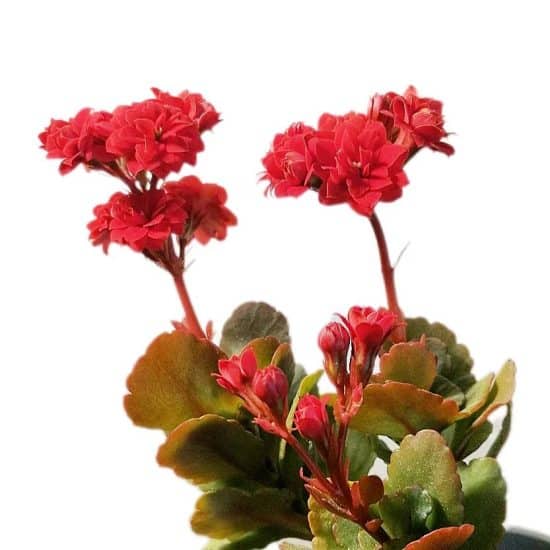
Spindly Growth
When there’s not enough light, Kalanchoe gets desperate and stretches out its stems and leaves, trying to reach for more sunlight. So, if you notice elongated stems, thin leaves, and less density than usual, your plant is probably dealing with spindly growth.
To help your leafy friend, try moving it to a spot with bright but indirect sunlight (near an east- or west-facing window). Just try not to fry your plant with too much direct sunlight—that’s a whole other headache! If you’re feeling fancy, you can use a grow light to supplement natural light, especially when winter’s gloomy days roll around.
Flowers Not Blooming
One specific struggle for growing Kalanchoe is poor blooming or a total lack of flowers. This could be caused by a few things like insufficient light, water problems, or the soil lacking essential nutrients. Keep an eye on your plant’s blooming patterns, watching for missing Kalanchoe blooms or a sad decline in blossoms.
To get those new flower buds back, make sure your Kalanchoe’s getting lots of bright, indirect light. Keep a consistent watering schedule, letting the soil dry a bit between waterings—nobody likes soggy feet! Oh, and don’t forget, a fertilizer made for blooming plants can work wonders for those flowers!
Pests and Diseases
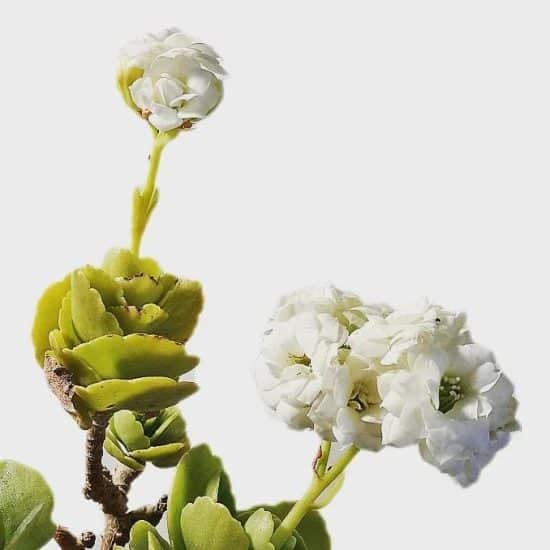
Kalanchoe plants are generally pretty tough cookies, but like all houseplants, they can have their moments of vulnerability. Let’s explore them so that you can be prepared.
Root Rot
You’d think a succulent like Kalanchoe wouldn’t have too many issues with rotting roots, but sometimes life happens and we accidentally overwater. To spot the problem, keep an eye out for yellowing leaves, a wilted look, and an unpleasant smell coming from the soil.
If you have a suspicious feeling, take your plant out of its pot and check the roots. Rotten roots will be dark, slimy, and mushy … yuck!
To fix rotting roots, trim the affected roots with sterilized scissors. Then, repot your plant in fresh, well-draining soil, ideally with some perlite or pumice thrown in for added aeration and drainage.
Ensure the pot has proper drainage holes, and remember: less is more when it comes to watering your Kalanchoe.
Mealybugs
Ah, mealybugs — those pesky little critters that love to invade our precious Kalanchoe plants. You’ll recognize them by their small, white, cotton-like masses on the leaves and stems.
To fight against these uninvited guests, start by removing as many as you can by hand or with a spray of water. Next, wipe the affected areas with a mixture of dish soap and water or some neem oil. Don’t forget to cover both sides of the leaves and stems!
To avoid a mealybug comeback, inspect your Kalanchoe regularly and keep it clean by gently wiping the leaves and stems with a damp cloth.
Powdery Mildew
This sneaky fungus can appear on your Kalanchoe when there’s low airflow and high humidity. To spot it on Kalanchoe leaves, look for white or gray powdery patches and stems as a telltale sign.
To treat powdery mildew, start by removing any affected leaves or stems, remembering to keep them away from your other plants. Then, apply a fungicide per the label instructions, ensuring that you cover the entire plant.
To prevent powdery mildew, give your Kalanchoe room to breathe by ensuring proper airflow. You can also control humidity by using a dehumidifier if needed.
Conclusion
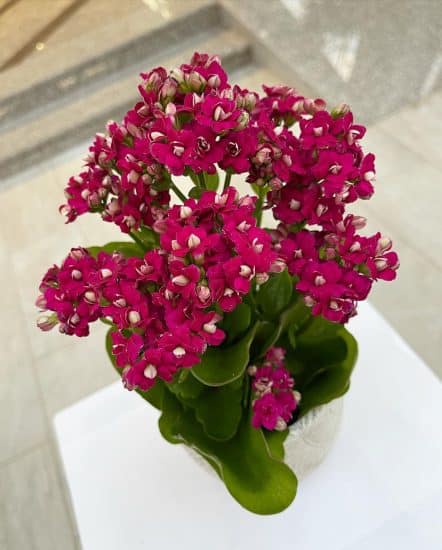
That’s a wrap for our Kalanchoe care and growing guide! You’re now equipped with all the knowledge you need to help your Kalanchoe blossfeldiana thrive in your home. Easy on the eyes and easy to care for — what could be better?
Kalanchoe care summary:
- Provide your Kalanchoe with bright, filtered light, avoiding harsh direct sun.
- Water sparingly, allowing the soil to dry between watering, and ensure proper drainage to prevent root rot.
- Keep the temperature between 55-80°F and maintain normal indoor humidity levels for a happy plant.
We hope this guide has been helpful and inspires you to become a proud Kalanchoe plant owner. If you have any questions or want to share your experiences, feel free to reach out to us.
Happy growing!
FAQ
How do you keep Kalanchoe blooming?
To keep your Kalanchoe blooming with those cheerful, vibrant flowers, there are a few crucial things you can do. First, make sure your Kalanchoe plant has the right amount of bright, indirect light – they adore consistency!
Secondly, make sure the soil dries out between waterings. Remember, the general rule of watering is every 10 days in the summer and every 2 weeks in the winter.
Lastly, fertilize your plant during the spring and summer months with a balanced indoor fertilizer or a potassium-rich option to encourage more Kalanchoe blooms and flowers.
Can Kalanchoe take full sun?
Although Kalanchoe plants love brightly lit spaces, they’re not big fans of direct sunlight. Full sun exposure, especially in the heat of summer, can cause scorching and burned leaves, fading colors, and hindered blooming. Instead, aim for filtered or indirect light to keep it happy and healthy.
You can use a sheer curtain to protect your plant from too much sun, or place it in a spot where it gets diffused light.
Is Kalanchoe an indoor or outdoor plant?
As an indoor plant, Kalanchoe plants charm with their beautiful blooms, compact size, and low-maintenance nature. All you need to grow Kalanchoe inside is the right lighting, watering, and temperature conditions for it to thrive.
On the other hand, Kalanchoes can be planted outdoors as well during the warmer months when temperatures stay above 50°F. Just be sure to acclimate them to outdoor conditions slowly. And, of course, don’t forget to bring them back indoors when the temperature starts to drop!

